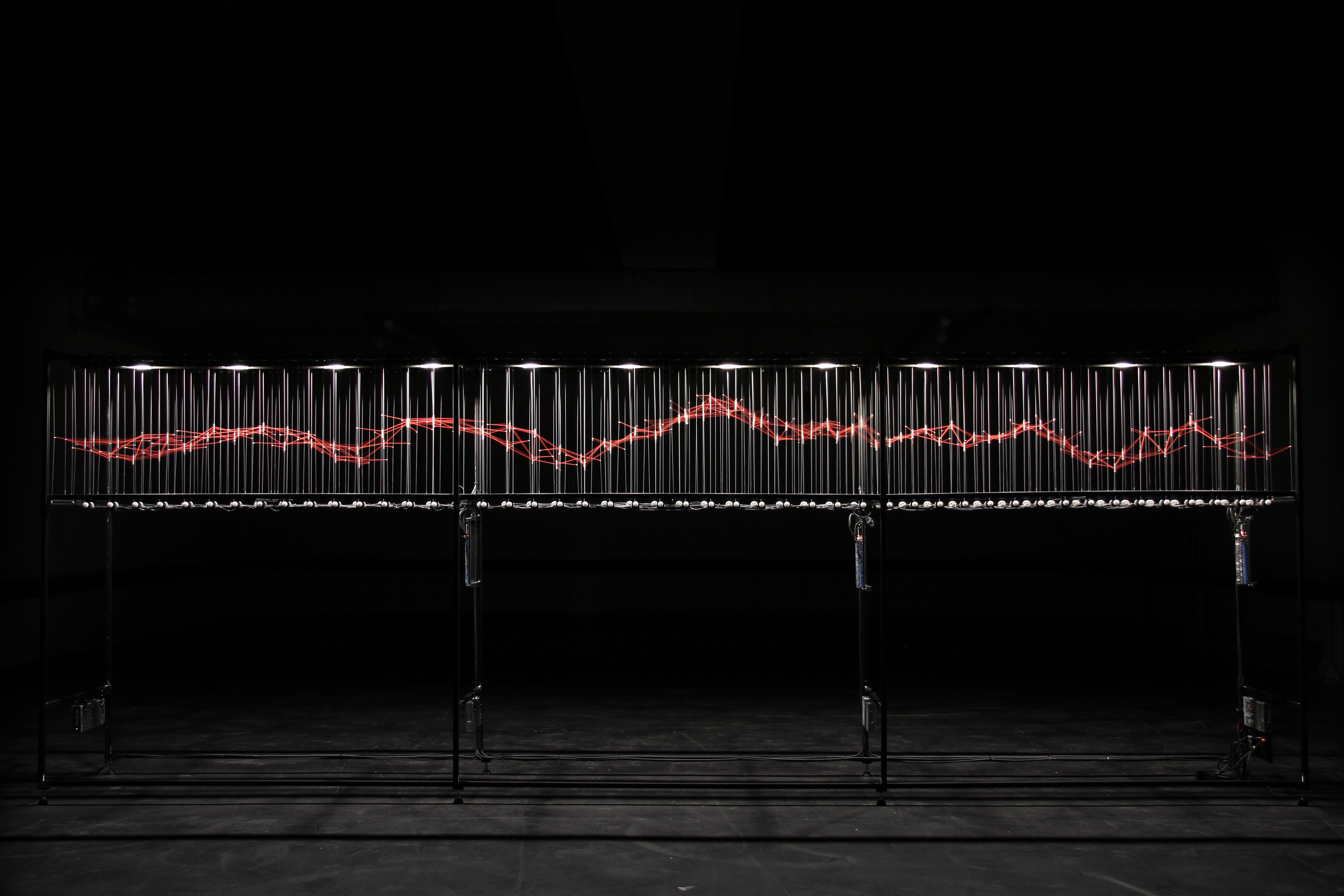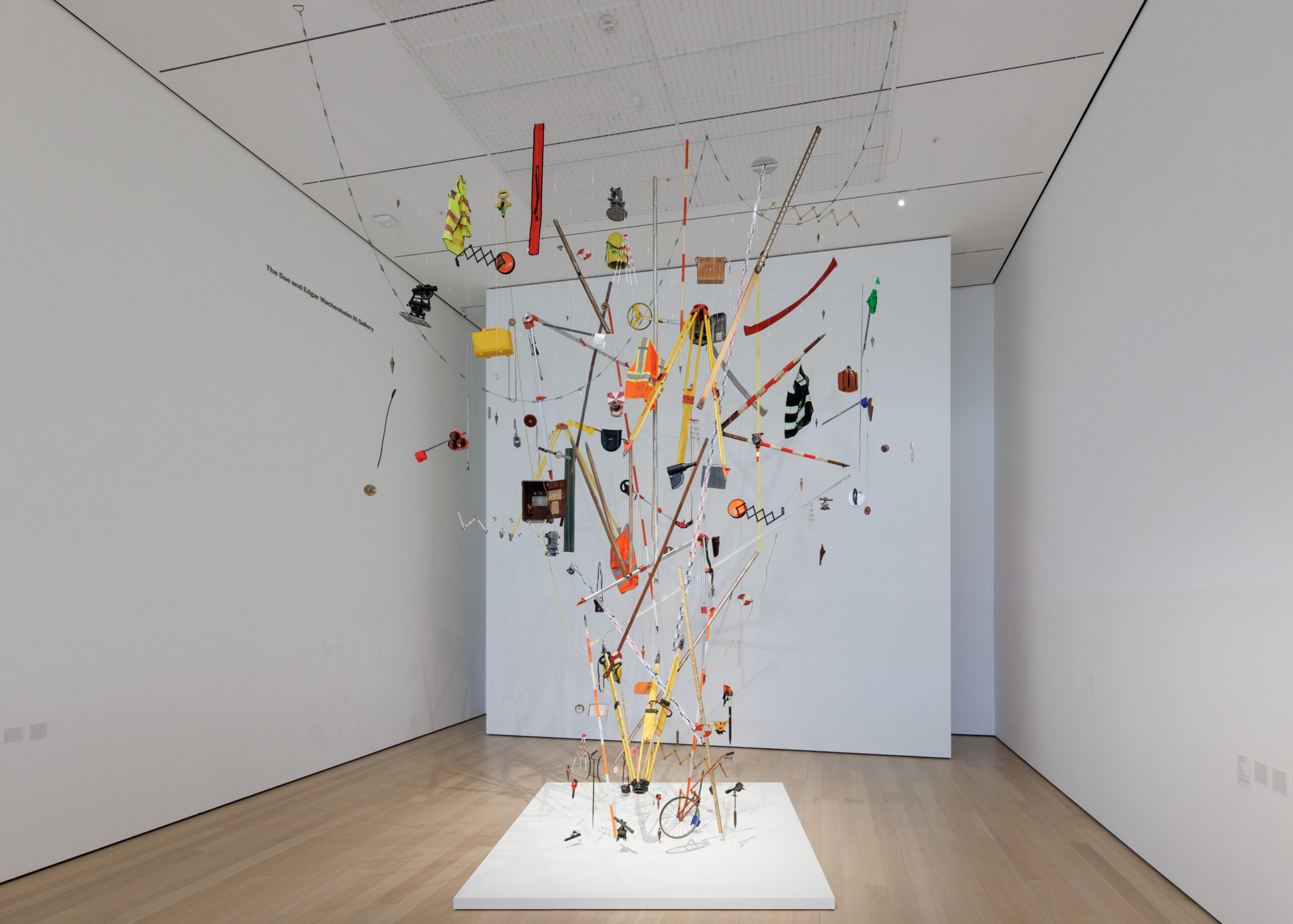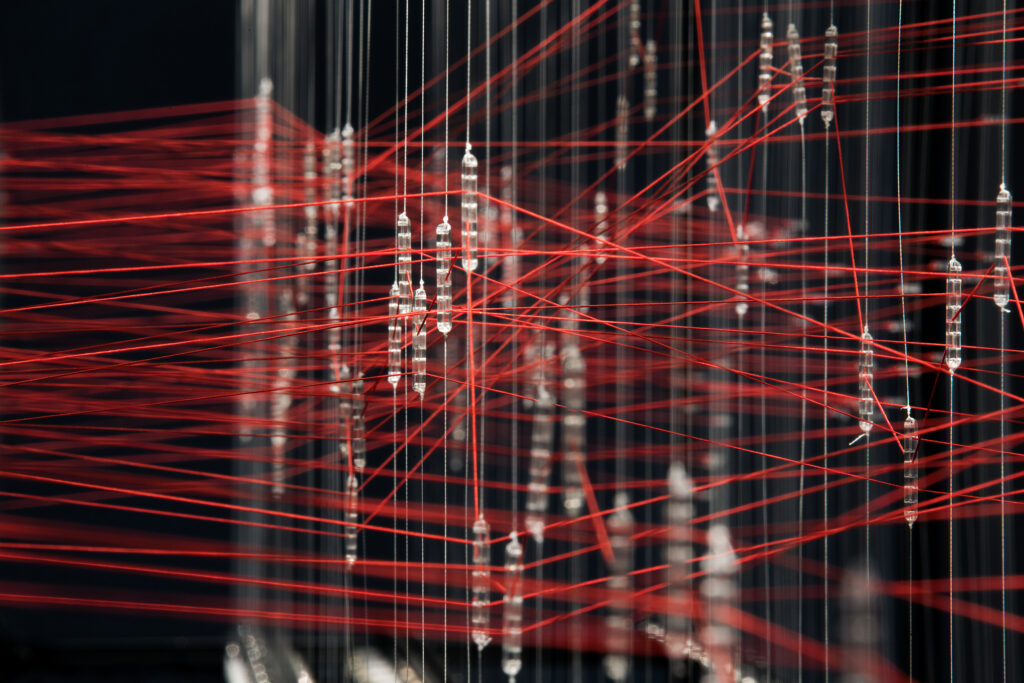
28 Aug The Dis-Ease in the Machine
Future Tense: Art, Complexity, and Uncertainty currently at the Beall Center for Art + Technology
By Chris Hoff
Since the emergence of cybernetics through people like Norbert Weiner, Gregory Bateson and others from the cold war avant-garde, and with the establishment of the systemic approach that tracked the relations between machine, man, and society. Artists have been interested in incorporating the language, tools, and metaphors of systems, prediction, and cybernetics into their work. These engagements have taken various forms, many of them critically examining the societal impacts of these technologies and the infrastructures that support them, while others have explored alternatives to technocratic approaches, emphasizing the creative and imaginative possibilities that lie beyond the predictable and chaotic.

Bresadola+Freese. Image courtesy of Ralf Baecker.
Future Tense: Art, Complexity, and Uncertainty currently at the Beall Center for Art + Technology continues the tradition of artists responding to frameworks of systems, prediction, and cybernetics. Organized by Beall Artistic Director David Famillian and part of Getty’s 2024 PST Art: Art & Science Collide initiative, this research project, exhibition, and symposium emerged from three years of interdisciplinary dialogue between artists and scientists at UC Irvine. Taking up space in both the University Gallery and the Beall Center for Art + Technology Future Tense offers a rich examination of the complex interplay between technology, complexity, and possibility.
Organized in three rooms which Artistic Director Familian referred to as the Chaos Room, the Liminal Room, and the Futures Room. Future Tense features sixteen artists and collectives who engage with complexity through several approaches including robotics, biology, AI, data surveillance, and bacterial intelligence.
Starting out in the Chaos room, which you enter through the University Art Gallery entrance, we are confronted at once by tools of measurement with a dark history. Measuring the Immeasurable (2020), by Carolina Caycedo and David de Rozas consists of vintage and contemporary surveying tools hung by line from the ceiling. Referencing the US Public Land Survey System (1785) which divided Native territories private plots forcing the Original peoples from their homelands. This piece does well to set the stage for the rest of the exhibit. It hangs as a warning that progress, organization, technology, in the service of capital and expansion, has terrible effects both visible and invisible, many that are not recognized until far down the road.

York, June 18, 2022 – January 02, 2023. © 2022 The Museum of Modern Art. Photo: Emile Askey
Located in the chaos room is one of the strongest works in the show. Interface I (2016)by Ralf Baecker captures the beauty of chaos through the action of 400 individual motors pulling a serious of strings and elastic bands that are prompted by unpredictable signals taken from Geiger-Muller tubes that detect ambient radiation rising from the earth. The movement of the strings and elastic bands is a visualization of randomness that becomes a hypnotic dance.

Bresadola+Freese. Image courtesy of Ralf Baecker.
Moving into the liminal room, the viewer is immediately confronted with Laura Splan’s 3D model of a nucleosome (a DNA cluster) that rapidly advances and recedes depending on where you might be standing in the room; this action leaves the viewer with a momentary sense of disorientation. Splan’s Baroque Bodies (Sway) is an interactive installation that represents the impact of the environment on gene expression. Visitors’ movements influence the views of the nucleosome mirroring how the environment, diet, social factors, and lifestyle, create epigenetic changes. Visitors are invited to engage with the delicate balance between our genetic makeup and the world around us, making the work not just an exploration of DNA and proteins, but a compelling reminder of our agency in shaping our own lives.

possible by the Simons Foundation. Created in collaboration with Adam Lamson, Science Collaborator
and theoretical biophysicist at Flatiron Institute, a division of the Simons Foundation. © Laura Splan.
Courtesy of the artist.
The standout work in the third room that represents the future was Hege Tapio’s Ephemeral. Humans have a long history of trying to control emotions, think love potions. Tapio’s Ephemeral continues this tradition into an imaginary future where venture capitalists embrace emotional AI or affective technologies by prototyping a transdermal implant that can create the artificial sensation of a preferred emotion. In Tapio’s Ephemeral, we glimpse the shadow of technology manipulating our emotions, suggesting that the future of affective control may be closer than we think—a future already hinted at by advancements like Elon Musk’s Neuralink, where the line between human experience and technological intervention blurs more each day.
Leaving Future Tense: Art, Complexity, and Uncertainty, I was struck by a lingering unease. The exhibition skillfully navigates the terrain of uncertainty, emergence, and the unforeseen, shedding light on the hidden forces that shape our expectations of an unpredictable future. This is not an exhibition that offers comfort or despair, but rather one that purposefully situates the viewer in that unsettling space between order and chaos. It reaffirms the vital role of artists as key contributors to the dialogue on foresight, future studies, and cybernetics, challenging us to confront the complexities of what lies ahead.
Future Tense: Art, Complexity, and Uncertainty Curated by David Familian will be on View: August 24 – December 14, 2024 at the UC Irvine Beall Center for Art + Technology



Sorry, the comment form is closed at this time.